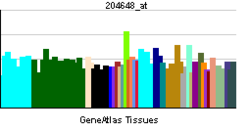- NPR1
-
Natriuretic peptide receptor A/guanylate cyclase A (atrionatriuretic peptide receptor A), also known as NPR1, is an atrial natriuretic peptide receptor. In humans it is encoded by the NPR1 gene.
Contents
Function
NPR1 is a membrane-bound guanylate cyclase that serves as the receptor for both atrial and brain natriuretic peptides (ANP and BNP, respectively).[1]
It is localized in the kidney[2] where it results in natriuresis upon binding to natriuretic peptides. However, it is found in even greater quantity in the lungs and adipocytes.[2]
References
Further reading
- Pandey KN (2002). "Intracellular trafficking and metabolic turnover of ligand-bound guanylyl cyclase/atrial natriuretic peptide receptor-A into subcellular compartments.". Mol. Cell. Biochem. 230 (1–2): 61–72. doi:10.1023/A:1014240006767. PMID 11952097.
- Lucarelli K, Iacoviello M, Dessì-Fulgheri P, et al. (2003). "[Natriuretic peptides and essential arterial hypertension]". Italian heart journal. Supplement : official journal of the Italian Federation of Cardiology 3 (11): 1085–91. PMID 12506509.
- Pandey KN (2005). "Internalization and trafficking of guanylyl cyclase/natriuretic peptide receptor-A". Peptides 26 (6): 985–1000. doi:10.1016/j.peptides.2004.12.020. PMID 15911067.
- Garg R, Pandey KN (2005). "Regulation of guanylyl cyclase/natriuretic peptide receptor-A gene expression". Peptides 26 (6): 1009–23. doi:10.1016/j.peptides.2004.09.022. PMID 15911069.
See also
External links
Other neuropeptide receptorsAngiotensin · Bradykinin (B1, B2) / Tachykinin (TACR1) · Calcitonin gene-related peptide · Galanin · GPCR neuropeptide (B/W, FF, S, Y) · NeurotensinType I cytokine receptor Enzyme-linked receptor Atrial natriuretic factor (NPR1, NPR2)Other B trdu: iter (nrpl/grfl/cytl/horl), csrc (lgic, enzr, gprc, igsr, intg, nrpr/grfr/cytr), itra (adap, gbpr, mapk), calc, lipd; path (hedp, wntp, tgfp+mapp, notp, jakp, fsap, hipp, tlrp) Receptor protein serine/threonine kinase Receptor tyrosine kinase Insulin receptor familyPDGF receptor familyFGF receptor familyVEGF receptors familyHGF receptor familyTrk receptor familyEPH receptor familyLTK receptor familyLTK · ALKTIE receptor familyROR receptor familyROR1 · ROR2DDR receptor familyPTK7 receptor familyRYK receptor familyMuSK receptor familyROS receptor familyAATYK receptor familyAXL receptor familyRET receptor familyuncatagorisedGuanylate cyclase-coupled receptor Receptor tyrosine phosphatase B trdu: iter (nrpl/grfl/cytl/horl), csrc (lgic, enzr, gprc, igsr, intg, nrpr/grfr/cytr), itra (adap, gbpr, mapk), calc, lipd; path (hedp, wntp, tgfp+mapp, notp, jakp, fsap, hipp, tlrp) Phosphorus-oxygen lyases (EC 4.6) 4.6.1 Adenylate cyclase
(4.6.1.1)Guanylate cyclase
(4.6.1.2)OtherB enzm: 1.1/2/3/4/5/6/7/8/10/11/13/14/15-18, 2.1/2/3/4/5/6/7/8, 2.7.10, 2.7.11-12, 3.1/2/3/4/5/6/7, 3.1.3.48, 3.4.21/22/23/24, 4.1/2/3/4/5/6, 5.1/2/3/4/99, 6.1-3/4/5-6 Categories:- Human proteins
- Membrane protein stubs
Wikimedia Foundation. 2010.


